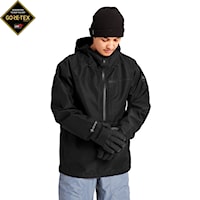How to Choose a Snowboard Jacket
27th October 2019 | 0 comments
Choosing a snowboard jacket can be a tricky business! They differ not only in fit and colour, but also in the degree of waterproofness and vapour permeability, the degree of insulation and the variability of individual parts ( detachable hood, number of ventilation holes, etc.).

Size of Jacket
Above all, a snowboard jacket should be big enough not to limit your movement. Try to lift your arms above your head in it. The ends of the sleeves should not come up to your forearms. Ideally, try the jacket on the clothes you will be riding in.
Insulated or Non-Insulated Jacket?
Snowboard jackets also have different levels of insulation. A lightweight jacket with no insulation and only a mesh lining will wick away body vapour best. You should consider buying one if you expect to be active and in constant motion. If you're more of a hot dog enjoyer type of rider and don't sweat too much when you ride, consider a jacket with insulation. They're slower to wick moisture away from your body, but provide nice thermal comfort. And the third option, a jacket made of GORE-TEX material, is the very best. This won't let the wet or wind get to your body. At the same time, it wicks moisture away from your body perfectly.

Waterproofness
In the mountains, conditions change literally from minute to minute. Even if it looks like a good sunbath in the morning and blue skies all day, suddenly a shower can come. So you don't have to run home and hide immediately, the jacket is waterproof. That means it can withstand both water and snow drops. The degree of water resistance is determined by the water column. This is the volume of water (in millimetres) that the jacket can withstand. From 10,000 millimetres upwards, you can be sure you're buying a model that won't let you down on the slopes and will keep you dry. In addition, taping all the seams is an essential part of the waterproofing.
Breathability
Another parameter worth paying attention to is definitely the breathability of the material. Without it, you'll feel like you're wrapped in a plastic bag when you play sports. The essence of breathability is therefore the ability to expel all excess moisture away from the body surface. So you shouldn't have to come back from the slopes in the evening and find your underpants completely drenched in sweat. The permeability value is given in grams per square metre per 24 hours, i.e. how many grams of water vapour a square metre of material will let through in one day. In addition to the term "permeability", you may also see the abbreviation MVTR. And with breathability, there is a rule of thumb: "The more the better".
Ventilation
Even if you buy snowboard clothing with a high level of breathability, you'll sweat more when you're active or going uphill. To prevent body vapour from condensing on the inside of the fabric, snowboard jackets have sewn-in zipped vents, called venting. These are most often located on jackets in the armpits or on the back. They can be easily unzipped to help quickly move body vapour away from the body.
Snowcatcher / Snow Skirt
Snowboard jackets are also equipped with a snowcatcher/snow skirt on the inside. This is a feature that protects the body from snow and wind. It fastens with buttons and can be detached on some jackets. To prevent it from rolling up, it is covered with rubber underneath. Nowadays, snowcatchers have loops that can be attached to the pants. No more snow piling up on your back under your jacket!










